LIPIcs.GIScience.2021.II.3.pdf
- Filesize: 4.45 MB
- 15 pages

 Creative Commons Attribution 4.0 International license
Creative Commons Attribution 4.0 International license

Routes with a high share of greenery are attractive for cyclist and pedestrians. We analyze how strongly such green routes differ from the respective fast routes using the openrouteservice. Greenness of streets was estimated based on OpenStreetMap data in combination with Sentinel-II imagery, 3d laser scan data and administrative information on trees on public ground. We assess the effect both at the level of the individual route and at the urban level for two German cities: Dresden and Heidelberg. For individual routes, we study how strongly green routes differ from the respective fast routes. In addition, we identify parts of the road network which represent important green corridors as well as unattractive parts which can or cannot be avoided at the cost of reasonable detours. In both cities, our results show the importance of urban green spaces for the provision of attractive green routes and provide new insights for urban planning by identifying unvegetated bottlenecks in the street network for which no green alternatives exist at this point.








Feedback for Dagstuhl Publishing